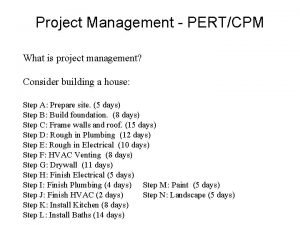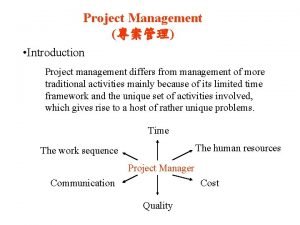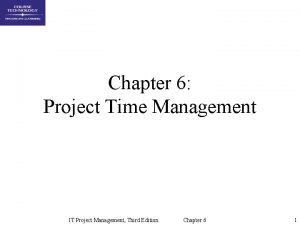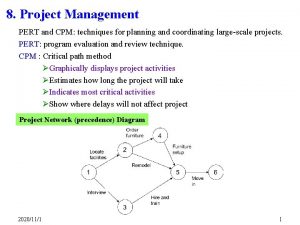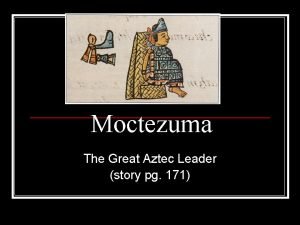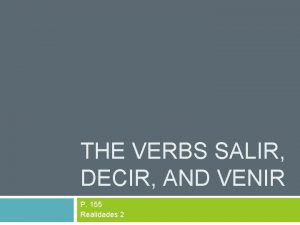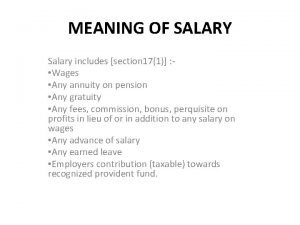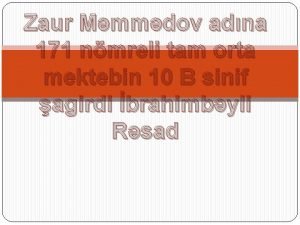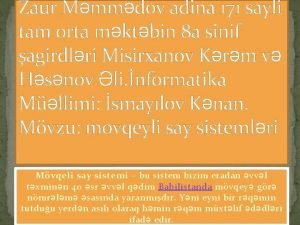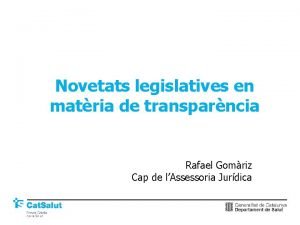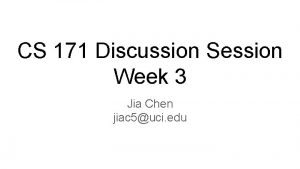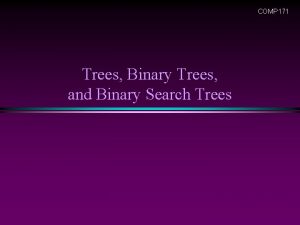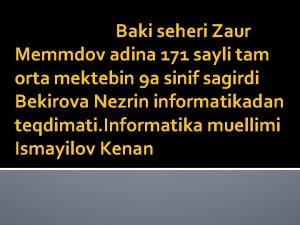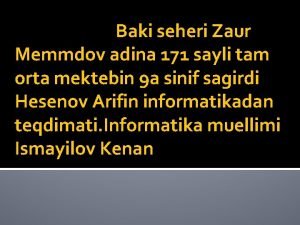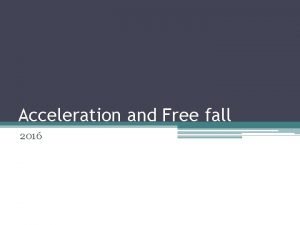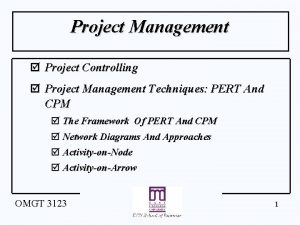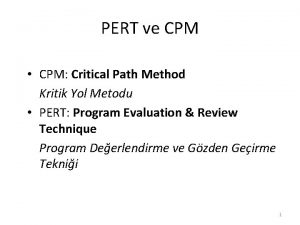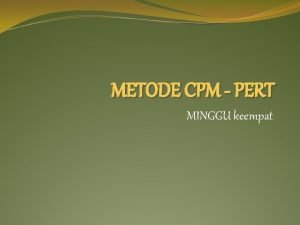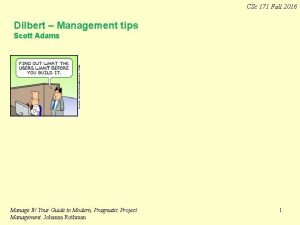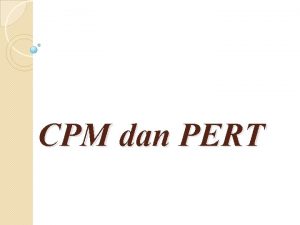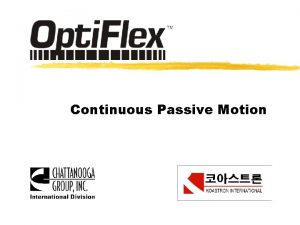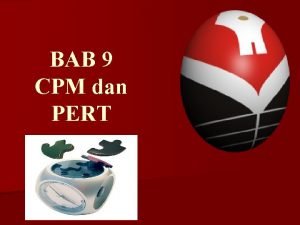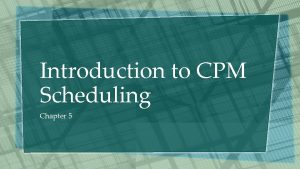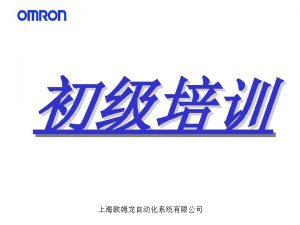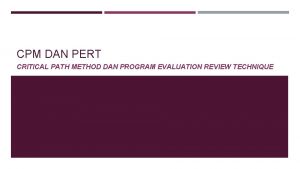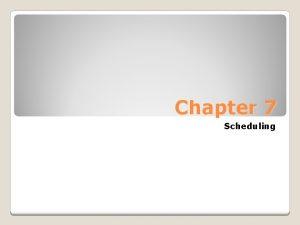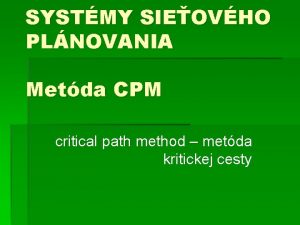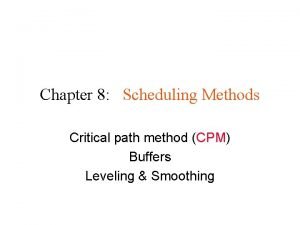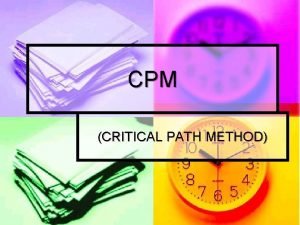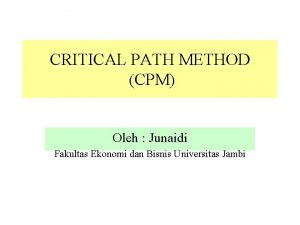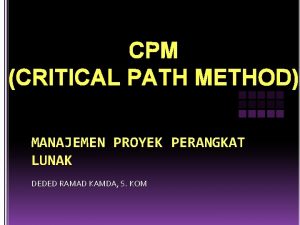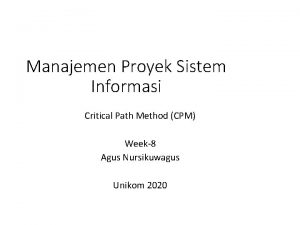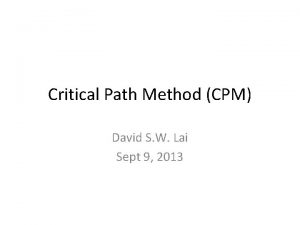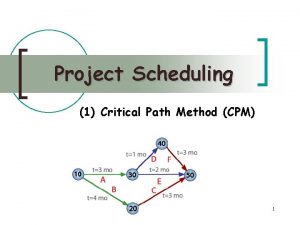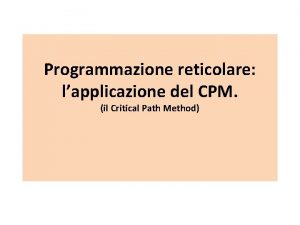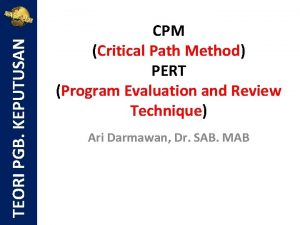CSc 171 Fall 2016 CPM Critical Path Management

























- Slides: 25

CSc 171 Fall 2016 CPM Critical Path Management) PERT (Program Evaluation and Review Technique) • Most commonly used methods for project management. • There are some similarities and differences between PERT and CPM. • PERT can be applied to any field requiring planned, controlled and integrated work efforts to accomplish defined objectives. • On the other hand, CPM is the method of project planning consisting of a number of well-defined and clearly recognizable activities. Manage It! Your Guide to Modern, Pragmatic Project Management. Johanna Rothman 1

CSc 171 Fall 2016 CPM • CPM uses activity oriented network. • Durations of activity may be estimated with a fair degree of accuracy. • It is used extensively in construction projects. • Deterministic concept is used. • CPM can control both time and cost when planning. • In CPM, cost optimization is given prime importance. The time for the completion of the project depends upon cost optimization. The cost is not directly proportioned to time. Thus, cost is the controlling factor. Manage It! Your Guide to Modern, Pragmatic Project Management. Johanna Rothman 2

CSc 171 Fall 2016 PERT • PERT uses event oriented Network. • Estimate of time for activities are not so accurate and definite. • It is used mostly in research and development projects, particularly projects of non-repetitive nature. • Probabilistic model concept is used. • PERT is basically a tool for planning. • In PERT, it is assumed that cost varies directly with time. Attention is therefore given to minimize the time so that minimum cost results. Thus in PERT, time is the controlling factor. Manage It! Your Guide to Modern, Pragmatic Project Management. Johanna Rothman 3

CSc 171 Fall 2016 PERT (Program Evaluation & Review Technique) CPM ( Critical Path Method) • Used to plan, schedule, and control a wide variety of projects • Schedule and coordinate the various tasks so that the project is completed on time • Managers want to know: What is the expected project completion date What is the scheduled start & completion date for each specific task Which tasks are “critical” and must be completed exactly as scheduled to keep the project on schedule How long can “noncritical” tasks be delayed before they cause a delay in the total project Manage It! Your Guide to Modern, Pragmatic Project Management. Johanna Rothman 4

How to Draw a Pert Chart CSc 171 Fall 2016 • Make a list of all the tasks that are required to complete the project. • Put the tasks in order by dependency. For example, two tasks are design and coding. You can't design and code until the requirements are specified. Requirements comes before design and coding. • Number (or letter) your sorted list, starting with assigning the lowest number (or letter) to the first task and the highest number to the last task. • Draw the graph, with earlier tasks on the left and later tasks moving right. Tasks that can be done at the same time should be vertically aligned. • Draw arrows from prerequisite tasks to the tasks that depend on them. Manage It! Your Guide to Modern, Pragmatic Project Management. Johanna Rothman 5

CSc 171 Fall 2016 The Network? Manage It! Your Guide to Modern, Pragmatic Project Management. Johanna Rothman 6

CSc 171 Fall 2016 The Network Manage It! Your Guide to Modern, Pragmatic Project Management. Johanna Rothman 7

CSc 171 Fall 2016 Manage It! Your Guide to Modern, Pragmatic Project Management. Johanna Rothman 8

CSc 171 Fall 2016 Critical Path Calculation ES: Earliest Start EF: Earliest Finish LS: Latest Start LF: Latest Finish Manage It! Your Guide to Modern, Pragmatic Project Management. Johanna Rothman 9

CSc 171 Fall 2016 For each task: Task ID and duration (t) ES EF Earliest start time Earliest finish time (ES + t) Earliest start: largest value of the earliest finish times for all predecessor tasks LF LS Latest finish time Latest start time (LF – t) Latest finish Rule: smallest value of the latest start time for all successor tasks

CSc 171 Fall 2016 For each task: Task ID and duration (t) ES EF Earliest start time Earliest finish time (ES + t) Earliest start: largest value of the earliest finish times for all predecessor tasks LF LS Latest finish time Latest start time (LF – t) Latest finish Rule: smallest value of the latest start time for all successor tasks

CSc 171 Fall 2016 For each task: Task ID and duration (t) ES EF Earliest start time Earliest finish time (ES + t) Earliest start: largest value of the earliest finish times for all predecessor tasks LF LS Latest finish time Latest start time (LF – t) Latest finish Rule: smallest value of the latest start times for all successor tasks

CSc 171 Fall 2016 Finding Latest Start & Latest Finish times • Start at the end of Project node • Use the assumed completion time (or merely set the LF of end of Project node to its computed EF) • The node’s LS is then set to its successor node’s LF time – the node’s duration • If the node has more than 1 successor node, the LS times for each successor node must be considered • The node’s LF values is set to the smallest of the successor nodes’ LS times Manage It! Your Guide to Modern, Pragmatic Project Management. Johanna Rothman 13

CSc 171 Fall 2016 • The LS times for the three successor nodes indicate the latest that the task can be started and still have the project completed on its expected completion date. • If the LF time was set to 12, you would overshoot the completion date by 7 • If it was 8, you would overshoot by 3 • The latest that you can start the first successor node is 5… and get the expected completion time (the LF for the finish node Manage It! Your Guide to Modern, Pragmatic Project Management. Johanna Rothman 14

CSc 171 Fall 2016 Assignment Handout Due - Monday Manage It! Your Guide to Modern, Pragmatic Project Management. Johanna Rothman 15

Draw the Network CSc 171 Fall 2016

CSc 171 Fall 2016 Network Manage It! Your Guide to Modern, Pragmatic Project Management. Johanna Rothman 17

Network CSc 171 Fall 2016

Homework Assignment Manage It! Your Guide to Modern, Pragmatic Project Management. Johanna Rothman CSc 171 Fall 2016 19

CSc 171 Fall 2016 Manage It! Your Guide to Modern, Pragmatic Project Management. Johanna Rothman 20

Project Tasks - example Manage It! Your Guide to Modern, Pragmatic Project Management. Johanna Rothman CSc 171 Fall 2016 21

CSc 171 Fall 2016 PERT Manage It! Your Guide to Modern, Pragmatic Project Management. Johanna Rothman 22

CSc 171 Fall 2016 Manage It! Your Guide to Modern, Pragmatic Project Management. Johanna Rothman 23

CSc 171 Fall 2016 Manage It! Your Guide to Modern, Pragmatic Project Management. Johanna Rothman 24

CSc 171 Fall 2016 Probability Project is completed earlier Probability Project is completed later Expected Project Completion Time Manage It! Your Guide to Modern, Pragmatic Project Management. Johanna Rothman 25
 Metoda cpm
Metoda cpm Critical semi critical and non critical instruments
Critical semi critical and non critical instruments Semi-critical
Semi-critical Critical path in project management
Critical path in project management Critical path in project management
Critical path in project management Pert formula
Pert formula Pert scale
Pert scale Conclusion of project work
Conclusion of project work Pg 171
Pg 171 29052007
29052007 Forms of decir
Forms of decir Nonlinear pricing strategies
Nonlinear pricing strategies Ai 171
Ai 171 Ai 171
Ai 171 Meaning
Meaning Informasiya prosesleri
Informasiya prosesleri 171 nomreli mekteb
171 nomreli mekteb Decret 171/2015
Decret 171/2015 Hazardous material table
Hazardous material table Cs 171 uci
Cs 171 uci 171 in binary
171 in binary 171 nomreli mekteb
171 nomreli mekteb 171 nomreli mekteb
171 nomreli mekteb Free fall 2016
Free fall 2016 Unity iot
Unity iot Project management pert
Project management pert



